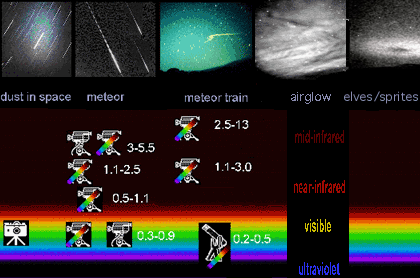|
Leonid MAC |
| home |
| View the shower |
| Mission Brief |
| Science Update |
| Media Brief |
| links |
|
Broad science objectives of Leonid MAC missions. See also: Leonid
science news.
Astrobiology: Leonid MAC is NASA's first Astrobiology mission. It's mission is to learn how extraterrestrial materials may have been brought to Earth at the time of the origin of life. In addition, the interaction of meteoroids with the atmosphere generates molecules that may have played a role in the origin of life on Earth. Our objectives are:
Not all meteoric matter is atomized during the plunge in Earth's atmosphere. Organic matter remained mysteriously undedected during last year's Leonid MAC. In a recent paper, Jenniskens et al. postulated that the organic matter may be lost in the form of large complex molecules that can readily emit the heat deposited by the violent collisions with air molecules before falling appart altogether. Such large molecules are not easily detected, except by their heat emission. Indeed, Ray Russell et al. discovered the fingerprint of organic matter in what may be meteoric debris in the path of a bright Leonid fireball. Pointing the mid-IR telescope onboard FISTA to the persistent train of the fireball, emission at 3.4 micron was detected that resembles the signature of complex organic matter observed in cometary dust. However, at present it can not be excluded that trace air compounds are responsible.
Read more: Nov. 13 - Organic fingerprint
Comet dust trails: The rate of meteors, when provided in near-real time, is practical information for satellite operators. It also provides a cross section of the dust density in the stream, which is a signature of processes of dust ejection. Individual meteors observed stereoscopically yield orbits in space. Remote sensing of the light and the breakup in colors called spectroscopy, yields information on meteoroid composition. Hence, meteor observations are a poor man's comet mission to probe otherwise invisible phenomena close to the comet nucleus. Hence for planetary astronomy our objective is:
Dec. 18 - Dec 22 Ursid outburst
DURING 1999 METEOR STORM, COMET DUST CRUMBLED LESS FINE Ian Murray et al. discovered from imaging onboard Leonid MAC that Leonids in the 1999 encounter fell appart in relatively larger fragments than did Leonids during the 1998 encounter. Both the 1998 and 1999 Leonid light curves were flat-topped, implying that the meteoroids quickly fell appart in fragments upon entry in the Earth's atmosphere, but the 1998 light curves tended to peak early in the trajectory followed by a gradual fading, while the 1999 light curves gradually ramped up to a late peak. The cause of this unexpected behaviour is not understood. Both encounters were with dust ejected in 1899. We now look forward to an encounter with the dust trail of 1932 on November 16/17, 2000. read more: Oct. 30 - Comet dust crumbled less fine
Satellite Impact Hazard: The Leonid meteoroids are an impact hazard. They represent a collimated beam of very fast (71 km/s) meteoroids that generate a relatively large and unusually highly charged vapor cloud when hitting a solar panel. Such cloud can penetrate important electronics and cause a short-out. Our objective is:

Earth's upper atmosphere: The molecules and debris left behind affect the atmospheric chemistry and physical conditions in the region between 80 and 120 km altitude, where airglow is normally observed. Persistent trains probe the atmosphere winds, molecular and turbulent diffusion, and gravity waves. Persistent trains enable telescopes to be pointed at the path of a meteor and probe airglow chemistry under unusual conditions. Much remains ununderstood about these striking phenomena. Also, during the 1999 Leonid storm, an unsual rate of elves and sprites were observed above cloud-to-ground lightning. A possible link between meteor activity and lightning phenomena is studied. Our objectives are:
Source Wavelength Height of emitting layer Intensity
H 656.3 nm geocorona 4-6 R (night)
[OI] 630.0 nm 250 - 300 km 60 R
[OI] 636.4 nm 250 - 300 km 20 R
Na D 589.0 nm, 589.6 nm 92 km 30-100 R
O2 (Herzberg bands) 300 nm - 400 nm 90 km 0.8 R/A
[OI] 557.7 nm 90 km 250 R
pseudocontinuum 400 nm - 700 nm 90 km 0.3 R/A
OH 600 nm - 4.5 micron 85 km 4.5 MR(all bands)
O2 864.5 nm 80 km 1 kR
EXAMPLE: ATMOSPHERE GETS A JOLT FROM LEONID STORM
Joe Kristl et al. report an increase in OH airglow emission during the peak of the Leonid shower. No such change was observed for sodium emission and O2 airglow emissions. It is not clear yet how the enhanced influx of meteoric matter caused the change in airglow chemistry. Despois et al. observed a decline of HCN molecules in the upper atmosphere one day after the Leonid storm.
Read more: Nov. 07 - Meteors affect atmospheric chemistry
A multi-disciplinary approach: Leonid MAC will utilize a wide range of innovative observing techniques to study the physical properties of meteors as they interact with the atmosphere. Each wavelength regime gives a different type of information:
 Figure: Observing targets (top) and spectral coverage of instruments (bottom). The observing targets include dust in space, meteors, meteor persistent trains, airglow and elves/sprites. The coverage of instruments show the different regimes of wavelength that are examined by different imagers and spectrographs.
|

